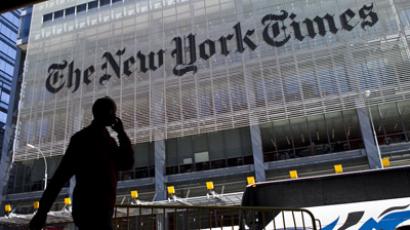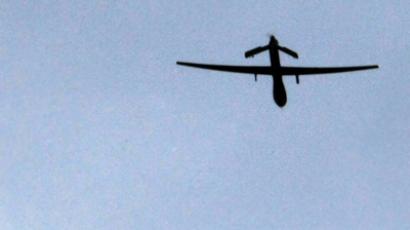Major US newspapers admit to honoring CIA demands

As incoming CIA chief John Brennan prepares to answer questions from Congress, some of the biggest names in US media are under attack for hiding a secret drone base that the Obama nominee helped build.
Reports in the New York Times and Washington Post this week confirm that the United States Central Intelligence Agency, which Brennan might very soon head, established a top-secret launching pad in Saudi Arabia used to send American drones into Yemen. From that elusive fort, the Obama administration gave the go-ahead for an unmanned aerial vehicle to travel into Yemen only months after the base was built in order to kill US citizen and suspected al-Qaeda operative Anwar al-Awlaki. Over a year later, the September 2011 death of al-Awlaki remains an issue of debate, and is expected to take center stage during Thursday afternoon’s confirmation hearing for Mr. Brennan, who will take the helm of the CIA if Congress approves of his testimony on the Hill. But while lawmakers are expected to offer hard-hitting questions regarding Brennan’s role in the administration’s drone program, US media is being attacked as well, albeit by critics who condone the fact that the Fourth Estate by-and-large left America in the dark about an important aspect of the country’s foreign policy. "It's been an open secret that it was there," one former national security official says of the base to ABC News on condition of anonymity this week.Despite having been identified by members of the press as early as 2011, the Saudi drone base has been left largely unreported by the US media until now. Just this week, the Post and Times both admitted that they were aware of the facility all along but complied with the CIA request to withhold this information.“The Washington Post had refrained from disclosing the location at the request of the administration, which cited concern that exposing the facility would undermine operations against an al-Qaeda affiliate regarded as the network’s most potent threat to the United States, as well as potentially damage counterterrorism collaboration with Saudi Arabia,” the paper explains .In a post published by the New York Times’ public editor on Wednesday, Margaret Sullivan shares that her paper stuck to the same theory:“The Times and other news organizations, including The Washington Post, had withheld the location of that base at the request of the CIA,” she says.Staying silent on information pursuant to national security isn’t unusual, but in the midst of an intensifying robot war overseas — and the potential appointment of the man who orchestrated it to a powerful new position — the Post and Times as well as Associated Press are being called complicit by their critics.President Barack Obama’s drone wars have unexpectedly become the basis for an onslaught of recent news articles, thanks largely to a leaked memo published by NBC this week that shows how the White House justifies the extrajudicial killing of American citizens with drones. Additionally, Mr. Brennan will testify before Congress on Thursday afternoon before lawmakers agree to confirm him for CIA chief, where he is expected to take the helm of a shadow drone war that, as the Times and Post will admit, has been purposely shielded from the public."The decision not to publish is a shameful one. The national security standard has to be very high, perhaps imminent danger," Lehigh University journalism professor Dr. Jack Lule tells the Guardian. "The fact that we are even having a conversation about whether it was a national security issue should have sent alarm bells off to the editors. I think the real reason was that the administration did not want to embarrass the Saudis – and for the US news media to be complicit in that is craven." Also up for question, though, is why the Post, Times and other opted to keep quiet on the Saudi base while at the same time publishing articles considered detrimental to national security. The New York Times may have refrained from publishing Saudi drone articles under the guise of protecting America, but the paper sang a different tune when it came to a top-secret cyberwar that was approved by both the George W. Bush and Barack Obama administrations. When the Times formally linked the White House last year to the Stuxnet worm that targeted Iranian nuclear facilities, Senate Intelligence Committee Chairwoman Dianne Feinstein demanded a probe belaunched to investigate any administrative leaks.“I am deeply disturbed by the continuing leaks of classified information to the media, most recently regarding alleged cyber efforts targeting Iran’s nuclear program,” the senator said last June. “This is like an avalanche. It is very detrimental and, candidly, I found it very concerning,” she said. “There’s no question that this kind of thing hurts our country,”Following the Times’ confirmation regarding America’s role in Stuxnet and the larger so-called ‘Olympic Games’ program launched against Iran, Sen. John McCain (R-Arizona) suggested the leak was a publicity stunt from the Obama administration. “The only conceivable motive for such damaging and compromising leaks of classified information is that it makes the president look good,” McCain said at the time. “They are merely gratuitous and utterly self-serving.”That isn’t to say, though, that the Times haven’t helped out the White House before. A series of articles penned by Times reporter Judith Miller before and during the George W. Bush administration tied weapons of mass destruction to Iraqi leader Saddam Hussein. Senior officials in the Bush cabinet would cite those articles in justifying the start of the Iraq War under Pres. G.W. Bush, only for her role with the paper to be terminated for that very reason in 2005. Not, however, before the paper could clarify her errors:"Ms. Miller may still be best known for her role in a series of Times articles in 2002 and 2003 that strongly suggested Saddam Hussein already had or was acquiring an arsenal of weapons of mass destruction… Many of those articles turned out to be inaccurate,” then-public editor Byron Calame wrote at the time. Then just last year, watchdog organization Judicial Watch unearthed emails that showed a New York Times staffer sharing an op-ed critical of the White House with a CIA source days before publication.“[T]his didn’t come from me… and please delete after you read,” Times reporter Mark Mazzetti wrote in an email to CIA spokeswoman Marie Harf, as obtained by Judicial Watch. The message went on to include an excerpt of a Maureen Dowd column that critiqued the spy agency’s role in supplying Hollywood with sensitive material to be used in the Osama bin Laden blockbuster ‘Zero Dark Thirty.’“This action was a mistake that is not consistent with New York Times standards,” Eileen Murphy, a spokesperson for the paper, was forced to respond.As more information develops on America’s drone war this week, though, the Obama administration is for once volunteering information. On Wednesday, the White House informed Congress that Pres. Obama gave the go-ahead for confidential drone memos to be made available to elected lawmakers. Whether or not that material makes it to the press, however, is another issue. Even then, though, it’s up to the media to decide whether or not its worth disclosing the truth about a shadow drone war that has been blamed for hundreds of civilian casualties since Barack Obama took office.














